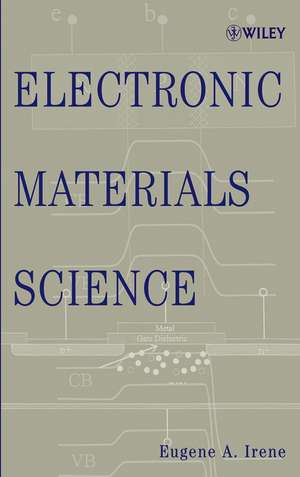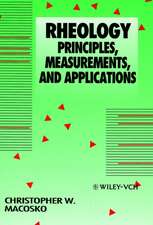Electronic Materials Science
Autor EA Ireneen Limba Engleză Hardback – 7 apr 2005
Preț: 1071.49 lei
Preț vechi: 1177.47 lei
-9% Nou
Puncte Express: 1607
Preț estimativ în valută:
205.08€ • 213.29$ • 171.86£
205.08€ • 213.29$ • 171.86£
Carte tipărită la comandă
Livrare economică 14-28 martie
Preluare comenzi: 021 569.72.76
Specificații
ISBN-13: 9780471695974
ISBN-10: 0471695971
Pagini: 320
Dimensiuni: 152 x 229 x 21 mm
Greutate: 0.64 kg
Ediția:New.
Editura: Wiley
Locul publicării:Hoboken, United States
ISBN-10: 0471695971
Pagini: 320
Dimensiuni: 152 x 229 x 21 mm
Greutate: 0.64 kg
Ediția:New.
Editura: Wiley
Locul publicării:Hoboken, United States
Public țintă
1st and 2nd year graduate students in chemistry and physics (not appropriate for introductory undergraduate courses) This title also serves as a self–teaching guide (includes many problems and examples) for upperlevel graduate students and/or practicing researchers needing a more advanced treatment of the fundamentals of electronic materials science.Cuprins
Preface.
1 Introduction to Electronic Materials Science.
1.1 Introduction.
1.2 Structure and Diffraction.
1.3 Defects.
1.4 Diffusion.
1.5 Phase Equilibria.
1.6 Mechanical Properties.
1.7 Electronic Structure.
1.8 Electronic Properties and Devices.
1.9 Electronic Materials Science.
2 Structure of Solids.
2.1 Introduction.
2.2 Order.
2.3 The Lattice.
2.4 Crystal Structure.
2.5 Notation.
2.6 Lattice Geometry.
2.7 The Wigner-Seitz Cell.
2.8 Crystal Structures.
Related Reading.
Exercises.
3 Diffraction.
3.1 Introduction.
3.2 Phase Difference and Bragg's Law.
3.3 The Scattering Problem.
3.4 Reciprocal Space, RESP.
3.5 Diffraction Techniques.
3.6 Wave Vector Representation.
Related Reading.
Exercises.
4 Defects in Solids.
4.1 Introduction.
4.2 Why Do Defects Form?
4.3 Point Defects.
4.4 The Statistics of Point Defects.
4.5 Line Defects--Dislocations.
4.6 Planar Defects.
4.7 Three-Dimensional Defects.
Related Reading.
Exercises.
5 Diffusion in Solids.
5.1 Introduction to Diffusion Equations.
5.2 Atomistic Theory of Diffusion: Fick's Laws and a Theory for the Diffusion Construct D.
5.3 Random Walk Problem.
5.4 Other Mass Transport Mechanisms.
5.5 Mathematics of Diffusion.
Related Reading.
Exercises.
6 Phase Equilibria.
6.1 Introduction.
6.2 The Gibbs Phase Rule.
6.3 Nucleation and Growth of Phases.
Related Reading.
Exercises.
7 Mechanical Properties of Solids--Elasticity.
7.1 Introduction.
7.2 Elasticity Relationships.
7.3 An Analysis of Stress by the Equation of Motion.
7.4 Hooke's Law for Pure Dilatation and Pure Shear.
7.5 Poisson's Ratio.
7.6 Relationships Among E, e, and v.
7.7 Relationships Among E, G, and n.
7.8 Resolving the Normal Forces.
Related Reading.
Exercises.
8 Mechanical Properties of Solids--Plasticity.
8.1 Introduction.
8.2 Plasticity Observations.
8.3 Role of Dislocations.
8.4 Deformation of Noncrystalline Materials.
Related Reading.
Exercises.
9 Electronic Structure of Solids.
9.1 Introduction.
9.2 Waves, Electrons, and the Wave Function.
9.3 Quantum Mechanics.
9.4 Electron Energy Band Representations.
9.5 Real Energy Band Structures.
9.6 Other Aspects of Electron Energy Band Structure.
Related Reading.
Exercises.
10 Electronic Properties of Materials.
10.1 Introduction.
10.2 Occupation of Electronic States.
10.3 Position of the Fermi Energy.
10.4 Electronic Properties of Metals: Conduction and Superconductivity.
10.5 Semiconductors.
10.6 Electrical Behavior of Organic Materials.
Related Reading.
Exercises.
11 Junctions and Devices and the Nanoscale.
11.1 Introduction.
11.2 Junctions.
11.3 Selected Devices.
11.4 Nanostructures and Nanodevices.
Index.
Descriere
This text covers traditional materials and science topics like diffraction, phase equilibria, structure and mechanical properties of solids, etc. , with the primary focus on electronic materials. It treats each topic at a higher level than is done in a typical undergraduate textbook.







